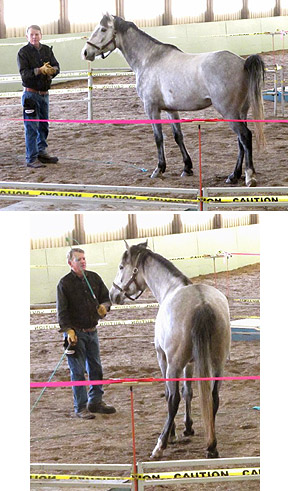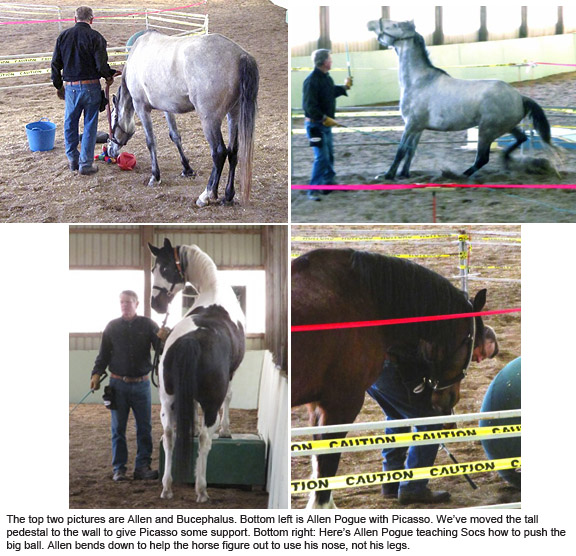 Here are two photos of Allen Pogue working with Bucephalus.
Here are two photos of Allen Pogue working with Bucephalus.
You’ll notice the round pen which is about two and a half feet high. It has an addition placed on top of it that raises the enclosure to over four feet in height. This extra barrier was thrown together Sunday when Allen was getting acquainted with the horses. Zelador was in the pen and Allen asked, “Has he ever heard a whip crack?” I replied, “No.” Allen was holding the Imagine a Horse longe whip that has a soft fluffy on the end. He made a quick flip with his wrist and the sound it made was a POP. Zelador deftly cleared the fence. I muttered, “That’s the last thing I wanted him to learn how to do.”
A few minutes later the whip popped again. Zelador’s bascule was beautiful. That’s when Ron, Bill and Allen raised the fence!
Allen commented, “He did that because you taught him to do that.” I thought back on the free jumping Christi and I created for Zelador… bloks with poles and a height of eighteen inches… tops! Nope, don’t think I taught him how to do that.
Moving right along, I’m very happy to report that Zelador politely stayed in the round pen for the remainder of the clinic and no other horse cleared it either.
The weather was sunny and above fifteen degrees each day. As a result we were able to work outside in a roundish pen attached to the south side of the lower barn. We brought one platform down from the arena and it’s still in the outdoor pen. I use it every day. It’s so handy to walk out of the barn, turn left, walk two metres and enter the pen.
Ciara’s horse Dart was one of Allen’s favourites. He said more than once, “It’s a privilege to work with this type of horse.”
Ciara has several tricks on Dart including the rear. Allen was shaping that into a rear, then a hind leg walk to the platform.
Allen reacquainted me with the endo-tapping. I learned this from him when I visited his Red Horse Ranch near Austin, Texas in 2006. The endo-tapping is a technique to help relax horses. You can create your own endo-tapper by taking a short, flexible riding crop and placing a two and a half inch in diameter foam ball on the end of it. You start by tapping the horse in a “sweet spot” located just below the withers. It’s an area about six inches wide and two or three deep. You can tap with varying rhythm and varying hardness/softness. What you’re looking for is a lowering of the horse’s head. When this happens you stop tapping. At first you would stop at the slightest hint that the head is going to lower…even an inch.
Over time the horse will drop its head to the ground after you tap once or twice. The low head and relaxed horse is a lovely way to start your session.
Allen tapped on Robin Monday evening. He tapped and tapped. Not much happened. There was a hint of downward “thought” and he stopped tapping. He walked her in a circle and began again. I missed that initial session, but was watching the Tuesday evening one. Allen tapped the sweet spot twice and Robin dropped her head to the ground. She was quiet and relaxed. Very happy in her body. Allen was quite surprised at the huge difference between Monday and Tuesday. I thought about Daniel Nummer and his GAP. Yep, Robin is a classic example of what a little GAP time can do to help a horse figure things out.
I endo-tapped Kye, Zelador and Zeloso once and I’m pretty sure they lowered their heads because they figured out that I’d stop tapping if they did. So I was wondering if the endo-tapping was actually creating relaxation. I’m guessing that a horse with his head almost on the ground isn’t terribly worried and perhaps subsequent tappings would show relaxation.
Allen explained that after the horse understands the sweet spot you can move along the side of the horse and eventually tap the rump. After that tapping elicits the dropped head you can tap any place where there’s muscle mass (not bone). You can endo-tap while riding, too.
Back in 2006 I did find some articles on the internet about endo-tapping. I haven’t looked recently. Bill created an endo-tapper from me in 2006. We placed a tennis ball on the end of a flexible short riding crop. I mentioned this to Allen and he thought the tennis ball might be a bit unyielding. He preferred a foam ball. What he used during the clinic was one of the wands with the green ball on the end of it. He wasn’t promoting that as an endo-tapper because the ball was about an inch too small in diameter. But he most certainly had excellent results with it. Horse after horse dropped its head and looked relaxed.
I mentioned to Allen that I wanted to learn some exercises to help Z and Z develop the piaffe. He has some video footage from the 1960s of an excellent trainer working on the piaffe. Allen said he’d send them to me. He put the piaffe on his white Arabian stallion in two weeks using long reins.
Bill, Allen and I took Zelador to the arena and worked him in the long reins. We actually got a few steps which hinted at the piaffe.
I’m waiting for more photos of the clinic. When I get them there will be more to tell.

